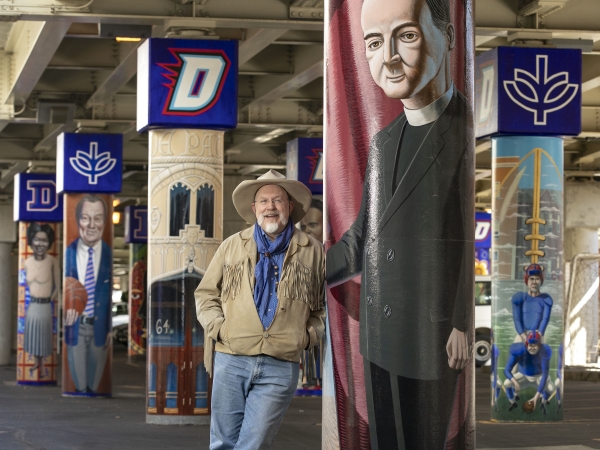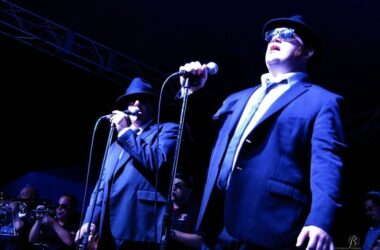
CHICAGO—(ENEWSPF)—September 27, 2018
By: Brother Mark Elder, C.M.
Murals honoring a DePaul University basketball legend, the former Blue Demon football program, the university’s first building in Chicago’s Loop, and the creation of the school’s Black Student Union are the newest works in a multi-year public art project to memorialize key figures and moments in DePaul’s history.
Residing under the Chicago Transit Authority’s Fullerton ‘L’ station on the university’s Lincoln Park Campus, “The Story of ‘The Little School Under the ‘L’’ — Under the ‘L’,” began in 2016 and is the vision of muralist Brother Mark Elder, C.M., an adjunct faculty member in DePaul’s art, media and design program.
The new murals honor:
- George Mikan, a 1946 DePaul alumnus and Blue Demon basketball star, who was a four-time All-Star, three-time scoring champion and five-time champion in the National Basketball Association, eventually earning induction into the Naismith Memorial Basketball Hall of Fame in 1959.
- DePaul’s collegiate football team, which competed from 1898 to 1938, playing most of its home games on a field located on West Belden Avenue near the university’s Lincoln Park Campus as well as Soldier Field and Wrigley Field for select contests.
- A building at 64 E. Lake St. in Chicago, which DePaul built in 1928 to serve as the first home of the university’s new Loop Campus before moving to East Jackson Boulevard in 1955. The Loop Campus helped DePaul serve Chicagoans who wanted to attend college but also maintain a full-time job in the city.
- The 50th anniversary of the university’s Black Student Union, which was the first organization of color at DePaul and created during the civil rights movement to help raise awareness of black culture and black issues on campus.
A dedication for the four new murals will be held at 11 a.m. Oct. 13 under the Fullerton ‘L’ tracks at Sheffield and Belden avenues. Attendance is free and open to the public.
Elder’s process from ideation to installation can take as long as 10 months. He finalizes the mural concepts in late fall, lays out and draws the murals during the winter, and works with a mural class of DePaul art students in the spring to paint the murals and prepare them to be moved under the ‘L’ tracks. A small group of students then joins Elder each summer for installation, where their hands-on work includes some final painting, preparing the canvases, and applying the murals carefully onto the pillars for drying. The murals, which are wrapped around the support pillars for the ‘L’ tracks, measure on average about 10 feet tall and eight feet in circumference.
“It’s important to have a passageway where our history is visible,” said Elder. “One of the goals of this project is to display in a tangible way the mission of the university and highlight the student experience.
“These new murals are an example of that. Mikan is a legendary, Paul Bunyan-type figure who was huge in the history of the early NBA. His early development through Coach Ray Meyer is legendary in its own way. With the football mural, it’s good for current students to know that we had the sport at one time and help explain why we don’t anymore. The 64 E. Lake St. building is an example of how we originally looked to meet the needs of students, and the founding of the Black Student Union is an important moment in the history of the university that helps explain how groups like it might shape the university going forward.”
These new murals join eight others installed in 2016 and 2017 that honor basketball’s Ray Meyer; law alumnus Benjamin Hooks; Olympian Mabel “Dolly” Landry Staton; former university president Rev. Francis Xavier McCabe, C.M.; and the first female and first African-American graduates of the university.
In total, 25 murals will be installed, 24 to highlight DePaul’s history and a 25th — which is already installed — that gives an artistic overview of the project. Elder’s plan includes adding four murals a year for three more years to finish the project. Each row of murals represents a different 20-year period in DePaul’s history, starting from its founding in 1898 on the pillars closest to Belden Avenue and moving north toward Fullerton Avenue.
Additional information about the previous murals is online at http://depaulne.ws/murals_2016 and http://depaulne.ws/murals_2017. The project’s official website is online at http://bit.ly/mural_website.
Source: www.depaul.edu








